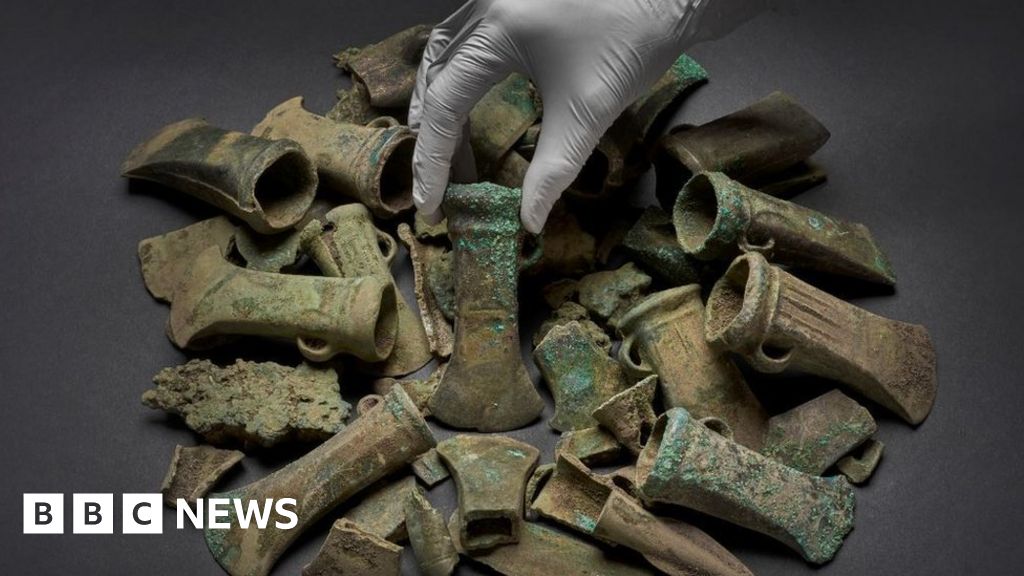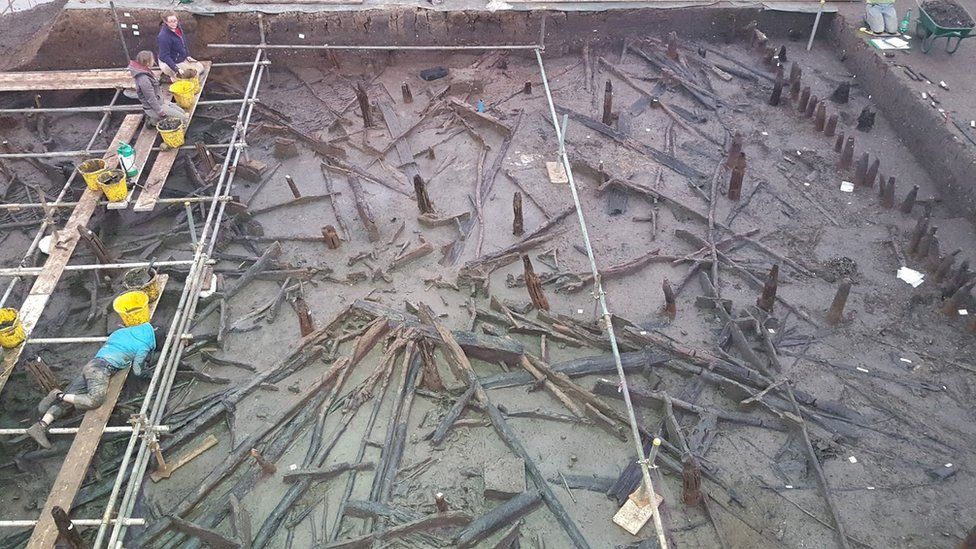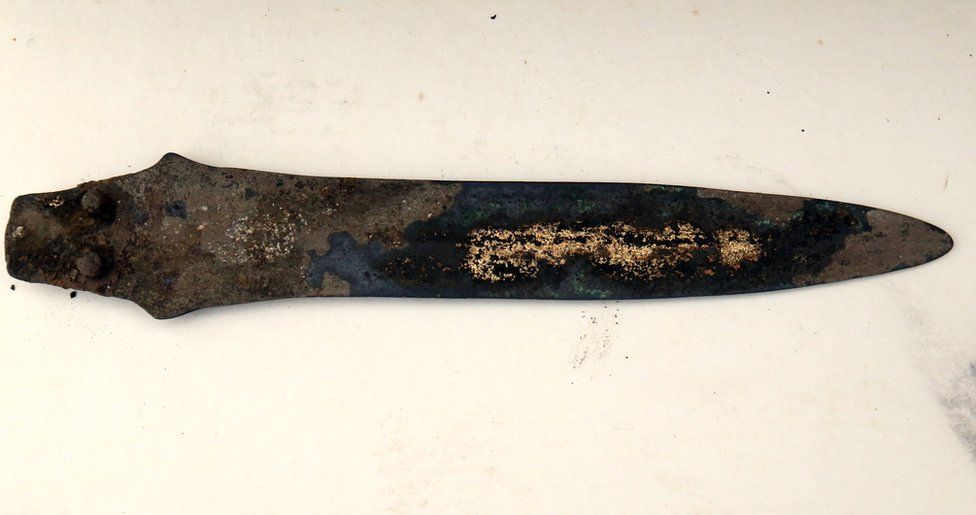Melodi
Disaster Cat
A bit of new and interesting information, I wonder if the newcomers were lighter-skinned? That would explain why some folks got a lot lighter really quickly around the Bronze Age, though it doesn't mean this was the only factor.

 www.bbc.com
Ancient mass migration transformed Britons' DNA
www.bbc.com
Ancient mass migration transformed Britons' DNA
By Paul Rincon
Science editor, BBC News website
Published1 hour ago
Share
 IMAGE SOURCE,LDRS
IMAGE SOURCE,LDRS
Image caption,
The migrants brought new ritual practices into Britain such as hoarding bronze objects in the ground. The picture shows a selection from the 453 artefacts found as part of the Havering Hoard in 2018
Scientists have uncovered evidence for a large-scale, prehistoric migration into Britain that may be linked to the spread of Celtic languages.
The mass-movement of people originated in continental Europe and occurred between 1,400 BC and 870 BC.
The discovery helps to explain the genetic make-up of many present-day people in Britain.
Around half the ancestry of later populations in England and Wales comes from these migrants.
It's unclear what caused the influx of people during the Middle to Late Bronze Age, but the migrants introduced new ritual practices to Britain.
The results, published in the peer-reviewed journal Nature, are based on DNA extracted from 793 ancient skeletons.
The study reveals that a gene allowing some people to digest raw milk increased rapidly in Britain during the Iron Age - 1,000 years before the same thing happened elsewhere in Northern Europe. It's an extraordinary example of natural selection for a genetic trait, and the reasons for its spread remain a mystery.
The researchers identified four skeletons at the archaeological sites of Cliffs End Farm and Margetts Pit in Kent that were either first-generation migrants from continental Europe, or their descendants.
 IMAGE SOURCE,CAMBRIDGE ARCHAEOLOGICAL UNIT
IMAGE SOURCE,CAMBRIDGE ARCHAEOLOGICAL UNIT
Image caption,
The very well-preserved dwelling site at Must Farm in Cambridgeshire dates to around the time of the migration
It's evidence for pioneer settlement of the region from the continent, starting as far back as 1,400BC.
At first, said Dr Thomas Booth, from the Francis Crick Institute in London, people with the new, continental ancestry "appear almost exclusively in Kent... but we don't really see them anywhere else and we don't see a change in the overall ancestry of Britain.
But the new DNA signature soon spreads: "From around 1,000BC, suddenly that ancestry seems to disperse all the way through southern Britain, particularly," he explained, adding: "There's no particular genetic change in Scotland, but everywhere in England and Wales, this ancestry has an effect."
Prof David Reich from Harvard Medical School in Cambridge, US, who led the research, told BBC News: "We estimate that about half the DNA of people in the Iron Age in Britain comes from these new migrants. What that means is if you trace back the ancestors of these Iron Age Britons 20 generations before the time they lived, half of them would not be living on the island of Great Britain."
As for where the initial migrants originated in continental Europe, their closest matches are with ancient populations in France. But says Prof Reich, "We don't yet have adequate sampling to directly confirm that or to see where exactly in France it would be."
When the newcomers arrived, the existing British population traced most of its ancestry to people who arrived at the end of the Neolithic, around the time Stonehenge was being built. They were part of a tradition known as the Beaker Culture.
The later, mid- to late Bronze Age movement of people brought new cultural practices to the country. This included the intentional burial of multiple Bronze objects - known as hoards - perhaps as offerings to the gods.
 IMAGE SOURCE,REPRODUCED WITH PERMISSION © WESSEX ARCHAEOLOGY
IMAGE SOURCE,REPRODUCED WITH PERMISSION © WESSEX ARCHAEOLOGY
Image caption,
A Late Bronze Age burial pit from Cliffs End Farm: the remains in the top right of the photo consist of several body parts deposited in a bag
The researchers also propose that the migrants and their descendants in Britain enabled the spread of Celtic languages.
Dr Lara Cassidy, an expert on ancient DNA from Trinity College Dublin, who was not involved with the latest study, called the findings "exciting", adding: "It provides a potential opportunity for language change on the island."
"Could this be the point at which the Celtic languages first enter the islands? I think the data presented here has moved the debate forward, however, it is far from conclusive."
It's not clear whether the migrants introduced this language group to Britain or were speaking just one type of Celtic. The branch of Celtic represented today by Irish and Scottish Gaelic - known as Goidelic - might already have already spoken by the existing inhabitants. Under this scenario, the newcomers may have spoken languages related to Welsh and Cornish - which belong to a different branch of Celtic known as Brythonic.
Co-author Prof Sir Barry Cunliffe, from the school of archaeology at the University of Oxford, told BBC News: "If the Mid-Bronze Age move had any effect at all on language, then the simplest hypothesis would be to see it as a vector for introducing, or strengthening Brythonic,"
"If so, then Goidelic had to have arrived earlier, either with Beakers, or earlier."
Also intriguing is the new study's finding that there was a rapid increase - during the Iron Age - in the frequency of a gene variant for digesting raw milk, something that's commonly known as lactose tolerance.
"It remains rare in Britain until the middle of the Iron Age, about 2,500 years ago. It's incredibly recent in evolutionary terms. In order for it to have gone from nothing to almost everybody in that period of time, your ability to digest raw milk must have been life or death," said Tom Booth.
 IMAGE SOURCE,PA
IMAGE SOURCE,PA
Image caption,
This middle to late Bronze Age dagger was recovered from Must Farm in 1969
"Adding to this whole craziness to some extent is that it becomes common in Britain 1,000 years before it becomes common in Northern Europe."
He added: "One of the leading possibilities is maybe that Britain went through a period of catastrophe like a famine or difficulty acquiring clean water sources. Then, what raw milk does is supply you with a clean source of hydration and food at the same time. Potentially, all you need are cows or sheep and you can make it through a disaster like that."
The mass-movement of people to Britain took place against the background of similar upheaval on the continent which, to some extent, homogenised the genetic make-up of Europeans.
"In this period there's convergence of ancestry throughout western and central Europe," said Prof Reich.
"In general, though there were exceptions, northern populations become more genetically similar to southern populations. And the southern populations become somewhat genetically more similar to the northern populations."
He said the exceptions were Scotland and the island of Sardinia, which were not as impacted by this North-South exchange.
Dr Cassidy said the prehistory of Britain and Ireland were closely intertwined, and that it was hard to understand one without the other. She said one of the obvious questions raised by this study was whether Ireland experienced a similar scale of inward migration during or after the Middle-Late Bronze Age.
"Characterising any differences in ancestry between Ireland and Britain during the Early Bronze Age will allow us to better understand the extent and direction of migration in subsequent periods."
She added: "If Ireland shows a similar pattern to Scotland, in that we find little evidence of substantial inward migration following the Early Bronze Age, we have to ask how and when was Celtic language introduced to that island."

Ancient mass migration transformed Britons' DNA
Scientists uncover evidence for a large-scale, prehistoric migration into Britain in the Bronze Age.
By Paul Rincon
Science editor, BBC News website
Published1 hour ago
Share

Image caption,
The migrants brought new ritual practices into Britain such as hoarding bronze objects in the ground. The picture shows a selection from the 453 artefacts found as part of the Havering Hoard in 2018
Scientists have uncovered evidence for a large-scale, prehistoric migration into Britain that may be linked to the spread of Celtic languages.
The mass-movement of people originated in continental Europe and occurred between 1,400 BC and 870 BC.
The discovery helps to explain the genetic make-up of many present-day people in Britain.
Around half the ancestry of later populations in England and Wales comes from these migrants.
It's unclear what caused the influx of people during the Middle to Late Bronze Age, but the migrants introduced new ritual practices to Britain.
The results, published in the peer-reviewed journal Nature, are based on DNA extracted from 793 ancient skeletons.
The study reveals that a gene allowing some people to digest raw milk increased rapidly in Britain during the Iron Age - 1,000 years before the same thing happened elsewhere in Northern Europe. It's an extraordinary example of natural selection for a genetic trait, and the reasons for its spread remain a mystery.
The researchers identified four skeletons at the archaeological sites of Cliffs End Farm and Margetts Pit in Kent that were either first-generation migrants from continental Europe, or their descendants.
- Ancient Britons 'replaced' by newcomers
- Study targets British DNA mystery
- DNA reveals origin of Stonehenge builders

Image caption,
The very well-preserved dwelling site at Must Farm in Cambridgeshire dates to around the time of the migration
It's evidence for pioneer settlement of the region from the continent, starting as far back as 1,400BC.
At first, said Dr Thomas Booth, from the Francis Crick Institute in London, people with the new, continental ancestry "appear almost exclusively in Kent... but we don't really see them anywhere else and we don't see a change in the overall ancestry of Britain.
But the new DNA signature soon spreads: "From around 1,000BC, suddenly that ancestry seems to disperse all the way through southern Britain, particularly," he explained, adding: "There's no particular genetic change in Scotland, but everywhere in England and Wales, this ancestry has an effect."
Prof David Reich from Harvard Medical School in Cambridge, US, who led the research, told BBC News: "We estimate that about half the DNA of people in the Iron Age in Britain comes from these new migrants. What that means is if you trace back the ancestors of these Iron Age Britons 20 generations before the time they lived, half of them would not be living on the island of Great Britain."
As for where the initial migrants originated in continental Europe, their closest matches are with ancient populations in France. But says Prof Reich, "We don't yet have adequate sampling to directly confirm that or to see where exactly in France it would be."
When the newcomers arrived, the existing British population traced most of its ancestry to people who arrived at the end of the Neolithic, around the time Stonehenge was being built. They were part of a tradition known as the Beaker Culture.
The later, mid- to late Bronze Age movement of people brought new cultural practices to the country. This included the intentional burial of multiple Bronze objects - known as hoards - perhaps as offerings to the gods.
- Building site ancient weapons hoard to go on show
- DNA study reveals Ireland's age of 'god-kings'
- Second Bronze Age hoard found on farm

Image caption,
A Late Bronze Age burial pit from Cliffs End Farm: the remains in the top right of the photo consist of several body parts deposited in a bag
The researchers also propose that the migrants and their descendants in Britain enabled the spread of Celtic languages.
Dr Lara Cassidy, an expert on ancient DNA from Trinity College Dublin, who was not involved with the latest study, called the findings "exciting", adding: "It provides a potential opportunity for language change on the island."
"Could this be the point at which the Celtic languages first enter the islands? I think the data presented here has moved the debate forward, however, it is far from conclusive."
It's not clear whether the migrants introduced this language group to Britain or were speaking just one type of Celtic. The branch of Celtic represented today by Irish and Scottish Gaelic - known as Goidelic - might already have already spoken by the existing inhabitants. Under this scenario, the newcomers may have spoken languages related to Welsh and Cornish - which belong to a different branch of Celtic known as Brythonic.
Co-author Prof Sir Barry Cunliffe, from the school of archaeology at the University of Oxford, told BBC News: "If the Mid-Bronze Age move had any effect at all on language, then the simplest hypothesis would be to see it as a vector for introducing, or strengthening Brythonic,"
"If so, then Goidelic had to have arrived earlier, either with Beakers, or earlier."
Also intriguing is the new study's finding that there was a rapid increase - during the Iron Age - in the frequency of a gene variant for digesting raw milk, something that's commonly known as lactose tolerance.
"It remains rare in Britain until the middle of the Iron Age, about 2,500 years ago. It's incredibly recent in evolutionary terms. In order for it to have gone from nothing to almost everybody in that period of time, your ability to digest raw milk must have been life or death," said Tom Booth.

Image caption,
This middle to late Bronze Age dagger was recovered from Must Farm in 1969
"Adding to this whole craziness to some extent is that it becomes common in Britain 1,000 years before it becomes common in Northern Europe."
He added: "One of the leading possibilities is maybe that Britain went through a period of catastrophe like a famine or difficulty acquiring clean water sources. Then, what raw milk does is supply you with a clean source of hydration and food at the same time. Potentially, all you need are cows or sheep and you can make it through a disaster like that."
The mass-movement of people to Britain took place against the background of similar upheaval on the continent which, to some extent, homogenised the genetic make-up of Europeans.
"In this period there's convergence of ancestry throughout western and central Europe," said Prof Reich.
"In general, though there were exceptions, northern populations become more genetically similar to southern populations. And the southern populations become somewhat genetically more similar to the northern populations."
He said the exceptions were Scotland and the island of Sardinia, which were not as impacted by this North-South exchange.
Dr Cassidy said the prehistory of Britain and Ireland were closely intertwined, and that it was hard to understand one without the other. She said one of the obvious questions raised by this study was whether Ireland experienced a similar scale of inward migration during or after the Middle-Late Bronze Age.
"Characterising any differences in ancestry between Ireland and Britain during the Early Bronze Age will allow us to better understand the extent and direction of migration in subsequent periods."
She added: "If Ireland shows a similar pattern to Scotland, in that we find little evidence of substantial inward migration following the Early Bronze Age, we have to ask how and when was Celtic language introduced to that island."
